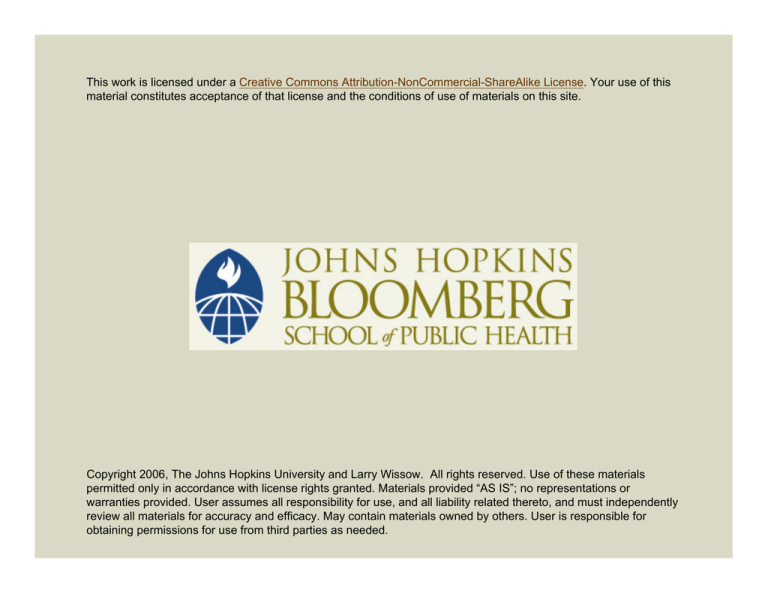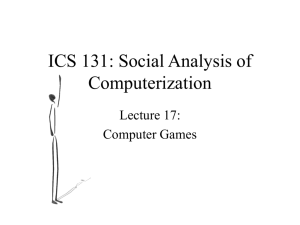
This work is licensed under a Creative Commons Attribution-NonCommercial-ShareAlike License. Your use of this
material constitutes acceptance of that license and the conditions of use of materials on this site.
Copyright 2006, The Johns Hopkins University and Larry Wissow. All rights reserved. Use of these materials
permitted only in accordance with license rights granted. Materials provided “AS IS”; no representations or
warranties provided. User assumes all responsibility for use, and all liability related thereto, and must independently
review all materials for accuracy and efficacy. May contain materials owned by others. User is responsible for
obtaining permissions for use from third parties as needed.
Cultural Perspective
Larry Wissow
Professor
Health, Behavior and Society
Johns Hopkins School of Public Health
Why think about health from a
cultural perspective?
How to define culture?
“Classic” anthropologic
definition of culture
“A framework of beliefs, symbols, and values
used to define one's world, express feelings,
and make judgments.”
Clifford Geertz, The Interpretation of Cultures
A socio-biologic view of
culture
Humans are a knowledge-using, cooperative
species
Our brains are “wired” to:
Infer other people’s goals and understand
the behavior relative to those goals
Learn and copy behaviors that will allow us
to function in collaboration with others
A sociobiologic view of culture
Culture as an “epidemiology of mental
representations” (Sperber)
“a pool of technological and social innovations that
people accumulate to help them live their lives”
[together] (Pinker)
A group of “shared arbitrary practices” that help
guide daily behavior and serve to regulate
interpersonal behavior (ie, make the intentions of
others more predictable)
A sociobiologic view of culture
Cultures differ when groups of people evolve
in isolation from each other
Isolation may be physical or voluntary
Differences preserved when:
Need for “behavioral identity badges”
High cost for individuals to make change
Cultures change when people see advantage
in what others are doing
Reasons to consider culture
To understand more about ourselves
Cultural knowledge is “overlearned” - accepted
as objective reality until confronted by contrast
or crisis (let’s pause to think about some
examples of “overlearned”)
Necessary to provide services
Obvious examples: differences in modesty,
trust, expectations for care
Other examples?
Dimensions of culture that may
be related to health
interventions
Individual versus collective orientation as a
determinant of how resources allocated
Family versus collective orientation as
determinant of how information is transmitted or
accepted
Culturally-sanctioned or prohibited behavior
related to health risk or health promotion
Culture-bound conditions
Salience or meaning of an illness varies
across cultures (schizophrenia)
Some illnesses appear not to occur across
cultures (anorexia, menopause)
Disease versus illness
Disease: abnormality of structure or function of
body organs and systems (Kleinman)
Illness: individual's experience of disvalued bodily
abnormalities or changes in social function
Experienced: abnormality may be real or
presumed
Disvalued: real abnormalities may or may not be
seen as problematic
The interaction of illness and
culture
...the subjective experience of illness is culturebound...
...the cognitive and linguistic categories of illnesses
characteristic of any culture constrain the
interpretive and behavioral options available in
response to symptoms
The illness process
Perception of a symptom
Inputs
Individual
Family
Community
Label as ill
Event
Cognitive
A “change”
Process
Is it noticed?
Interpretation
Is it a symptom?
Is the person ill?
Culture
Degree of attention to
internal states
Available labels
Prevalence/past
experience
Knowledge
Social implications
Action
Seek help
Hierarchy of helpers
Community-specific
barriers
Social construction of illness
Example: A “cold” in a school-aged child
family tradition determines whether this is
recognized as a pathologic state or part of
normal life experience
family tradition and constraints dictate to
what extent sick role is available and
accommodations that are required
Interpretation of symptoms
Example: Flathead reservation (Montana) (O’Nell)
Study of individuals meeting DSM criteria for
major depression
Have core symptoms of low energy, appetite,
sleep disturbance, thoughts about death
How are symptoms described?
loneliness rather than sadness the main
idiom
loneliness related to social relationships,
which are a core value in the culture
Three clusters of depressed
feelings
Aggrieved - chastised, jilted, ignored
Bereaved - grief for things that are gone,
missing people, lost tribal values
Worthless - feeling as if one would be
abandoned, unworthy, reproachful of self for
not living up to responsibilities to others
Pathologic?
Only “worthless” is seen as pathologic within
the culture, associated with suicidality,
something to be treated.
aggrieved and bereaved not seen as illness by
person or peers
to be bereaved is seen as a sign of maturity,
attitude befitting an elder
to be aggrieved is natural condition after certain
situations
Acculturation
Process of adaptation to living in a culture
different from one's own
Many definitions and proposed “endpoints”
(Hunt, 2004)
Often conceptualized as adoption of
language, values, tastes, behaviors of “host”
cultures
Early views pre-supposed a hierarchy from
primitive to civilized; traditional to modern
What are possible endpoints?
Assimilation to various degrees
Sufficient adoption of new behaviors and attitudes
to the point where identification with culture of
origin no longer create a difference “life chances”
relative to others (Richard Alba)
Polarity with “multiculturalism”
Parallel existence of disparate groups
Neither obviously good or bad
Neither likely to exist in pure form
What is cultural competence?
Elements of a cultural formulation
Cultural reference group(s)
Self-described, includes groups to which individual
feels belongs or is distinct from
Degree of certainty about membership
Language
Degree to which speak/understand language
identified with cultural reference group
Elements of a cultural formulation
Involvement with cultural reference group
Participation in activities, structures, degree of
knowledge
Degree of pride/shame associated with
membership
Elements of a cultural formulation
Involvement with other (possibly “host”
culture)
Competency in language, knowledge of activities,
structures
Experience of acceptance/power relationships
Relative amount of time spent in referent vs. host
culture
Comfort functioning in other cultures
When meet across cultures:
Transactions between explanatory models
Need for mutual respect
Both “sides” fear disrespect of their model
Getting both models “on the table” is the
beginning of the transaction
Professionals can’t always articulate their
model in comprehensible ways
To elicit explanatory models
(Kleinman)
1. What do you think has caused your
problem?
2. Why do you think it started when it did?
3. What do you think your sickness does to
you? How does it work?
4. How severe is this sickness? How long will
it last?
To elicit explanatory models
5. What kind of treatment do you think you
should receive?
6. What are the most important results you
hope to get from the treatment?
7. What are the chief problems your sickness
has caused you?
8. What do you fear most about your sickness?
What approaches work?
For clinicians and public health professionals
Start with awareness that differences possible
How to sensitize to differences without stereotyping?
Consider cultural patterns as hypotheses not generalizations
Know the history of interactions with other cultures
Conditions in the country of origin (if immigrants)
Experiences of oppression or discrimination
Remedy barriers to communication
Availability of translators and written materials
Great undersupply of trained translators
Outcomes clearly better in encounters where clinicians and
patients speak same language
What approaches work?
For professionals and public health educators
Allowing sufficient time in clinical encounter,
educational session, or program development to
develop a mutual understanding
Make the setting less strange: objects, pictures
from all participating cultures create common
ground
What approaches work?
For educating, informing, motivating
Use spokespersons from the culture
The verbal message is not the whole message
Consider problems the population has in
encounters with other institutions
Schools, government agencies, etc.
Differences in American Indian versus
“Western” help-seeking patterns
(over-generalizations)
Attitude
American Indian
“Western
Orientation toward
prevention
Framed as maintaining
harmony, countering or
avoiding exposure to
certain general
influences
Identifying undesired
outcome
Willingness to talk about
possible harm
Talking about bad things
can make them happen
Awareness of possible
harm seen as motivating
First source of care
Home/folk remedies;
advice from family and
friends
Same
Differences in American Indian versus
“Western” help-seeking patterns
(over-generalizations)
Attitude
American Indian
“Western
Choice of sources
Choose traditional or
“Western” based on
problem
biomedical
Need for appointment
“don’t care enough”
Like order; “my time”
Expectation of provider
Should know what is
wrong; should be
person of stature
Questions expected;
partnership but also
authority
Differences in American Indian versus
“Western” help-seeking patterns
(over-generalizations)
Attitude
American Indian
“Western
Expectation for
diagnosis
Events/actions that
threaten intra or
interpersonal
equilibrium
Biological hypotheses
Expectation for healing
Treatment brief but
intense; expect and
need involvement of
community
Extended treatment
accepted; expect
privacy
Expectation for
prescription
Expect behavioral
treatment
Expect medication
Culture and public health
Degree to which individuals feel responsible
for family and community
Generally higher among African-Americans and
Latinos than Whites in US
Attitudes toward sexuality
What happens if you abstain
Is touching yourself ok?
Is sexual knowledge the same as experience (and
thus bad)?
Culture and public health
Mobilizing individuals and communities
faith in ultimate “reward” among AfricanAmericans
great perseverance but fatalism toward adversity
“justice” orientation among US Whites
easily frustrated when short-term fixes fail
Willingness to seek help
the strong are silent
talking it out is a sign of weakness
Culture and public health
Orientation toward family
Many cultural groups make decisions either
involving extended family members or giving
authority to a particular member
Different standards may apply for men and women
within the family
Gail Wyatt: “We raise our daughters and spoil our sons.”
Culture and public health
Orientation toward outside authority
Different ideas about what information is privileged
Different concerns about loss of control or harm at
the hands of outsiders
Native American Breast
Health Project
Focus groups to understand attitudes toward breast
health
Art contests to develop ideas for appropriate
illustrations
Focus on health not cancer
Not appropriate to have a breast on the brochure
Models on existing brochures looked like “Barbie”
Illustrations of tribal art and symbols on brochures gave
women a sense that materials created for them






